Port Hardy
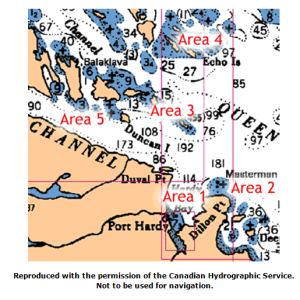 Port Hardy is a busy town located on the northern inside tip of Vancouver Island. Port Hardy has accommodations, restaurants, boat and auto repair shops, campgrounds, tackle shops and general stores. The Port Hardy residents are very nice folks and are usually more than willing to share information or help the visiting angler.
Port Hardy is a busy town located on the northern inside tip of Vancouver Island. Port Hardy has accommodations, restaurants, boat and auto repair shops, campgrounds, tackle shops and general stores. The Port Hardy residents are very nice folks and are usually more than willing to share information or help the visiting angler.
Port Hardy is located where the great migrations of salmon coming from the Gulf of Alaska and the Queen Charlotte Islands first encounter land and sports fishermen. All five species of salmon pass through these waters every year. Chinook, Coho, sockeye, chum and humpies begin to funnel down the inside of Vancouver Island heading for their spawning beds.
In the past, Port Hardy was the base for a large commercial fishing fleet that could wipe the waters clean of salmon in only a few days. With the dramatic cut-back in the commercial fishing fleet in British Columbia in an effort to restore salmon runs, the commercial fishery no longer impacts the sport fishery.
The waters around Port Hardy are perhaps some of the calmest waters on the coast during the summer. Fog is often a factor in the early morning, which is not a problem for anglers equipped with GPS, as long as they set their waypoints when the weather is clear, and watch their speed. Every afternoon about 3:00 PM, the wind starts to pick up and blow. The small boat angler should make sure he is back in the friendly confines of Hardy Bay at that time. Fog usually has lifted by 8 or 9:00 in the morning so that you can easily reach the fishing grounds. Those anglers that are GPS challenged, should have, at least, a good compass and know how to use it.
The handheld GPS units are now so inexpensive and so user friendly it is a shame people go out without one. I also recommend a VHF radio as a safety necessity, as few anglers, if any, monitor CB’s in Canadian waters.
Fishing Seasons
While salmon and halibut are in the area year round, winter weather usually precludes most anglers making the trip then. Salmon angling usually starts around the middle of June and continues into late September.
Chinook: The first great runs of Chinook usually begin to arrive out of the northern waters about mid-June. The early Chinook often are in great numbers and average in the 20 to 30 pound range. Their sizes increase in July with 30 pounders common and bigger fish caught.
Most of the Chinook have passed through by the end of August. However, if you want big Chinook and do not care about the number, the last week of August – first 10 days of September is the time to be in Port Hardy.
Coho: By the middle of July Coho have arrived in good numbers and since the cutback in commercial fishing in British Columbia, their size and numbers can be eye popping to Washington fishermen. Early Coho are usually in the nine – twelve pound range with some bigger. By the last week of July, Coho in the teens are common and every year we have brought 20 lb plus Coho to the boat in July and August. September Coho to 25 pounds are fairly common as well as some of the largest Chinook of the year.
Sockeye: Sockeye usually start to show from mid-June and continue into mid-September. Millions of sockeye will pass through this area. The seasons usually open and close depending on the strength of the runs and rivers where they are returning to spawn. Sockeye are not only the best of all the salmon to dine on, but they can be a spectacular fighter when hooked on light tackle.
Humpies: Humpies or pinks are available every year, primarily during July and August. Northern Vancouver Island has a run of humpies every year. The odd year 2001, 2003, 2005 etc. will be primarily Fraser River stock. These can be larger than the typical Washington humpy. We have taken the odd year humpy up to fourteen pounds.
The even year humpie (2002, 2004, 2006) will be smaller, but great sport on a light rod. Humpies are excellent eating if properly taken care of. Bleed your humpy immediately upon catching; clean and ice it down within 15 minutes. If you let your humpy go uncleaned and stewing in their own juices, they go soft quite quickly. Humpies are great for smoked fish.
Chum: Usually chum are the first of the salmon to arrive, coming through the area in late August and September. Pound for pound, caught in saltwater, chums are without a doubt the hardest fighting of all the salmon.
Halibut: This great flat fish is abundant all year and numerous halibut are taken exceeding 100 pounds. The average halibut is usually 20 – 30 pounds, but every year halibut over 200 pounds are caught. The record halibut for this area is 400 pounds +, apparently caught by a commercial fisherman. A great many halibut are caught while trolling for salmon.
Fishing Areas
 Area 1: Hardy Bay – Anglers never need to leave Hardy Bay to have excellent fishing. The middle of the bay often fills with Coho, humpies, sockeye and the occasional Chinook. Fish will dip in on the incoming tide before continuing their spawning runs to local rivers or rivers on the mainland. If you never went any farther, a good angler could have a 30 fish day here, if, of course, the salmon have moved in.
Area 1: Hardy Bay – Anglers never need to leave Hardy Bay to have excellent fishing. The middle of the bay often fills with Coho, humpies, sockeye and the occasional Chinook. Fish will dip in on the incoming tide before continuing their spawning runs to local rivers or rivers on the mainland. If you never went any farther, a good angler could have a 30 fish day here, if, of course, the salmon have moved in.
1a) Daphne Pt. – This area is usually a hot spot for humpies and a year round fishing spot for Chinook.
1b) Duval Pt. – This is the location of the outstanding Duval Pt. Lodge. This area can be a bit crowded, as many anglers going to Port Hardy never go any further to fish. Indeed, who can blame them? All five species of salmon can be caught here as well as halibut. So, if you just want to fill a cooler with fish, start here, as wave after wave of fish pass Duval Pt. This is another area your boat could have a 30 fish day.

Area 2: Masterman Islands – This area offers good fishing for Chinook and Coho. If the wind picks up out of the northwest, this is a place to duck around the point and get out of the chop. You can fish all the way down past Peel Island and Beaver Harbour, finding Chinook and Coho along the way. This area usually has little fishing pressure.
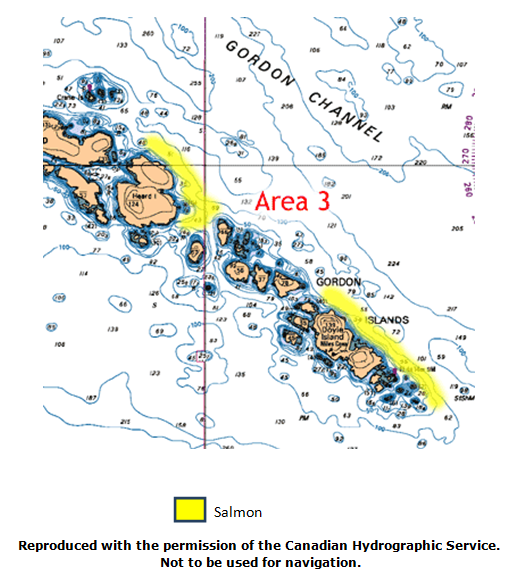
Area 3: Gordon Islands – The Gordon Islands are the first string of islands past Hardy Bay. The southern island, Doyle, offers good mooching off the rocks and shoals. Trollers should fish close to the shores for Chinook. Move out to the rips for Coho and sockeye. This shoreline can be trolled all the way past Hurst Island to Christie Pass and fish could be caught anywhere in this area. The marked areas are the hot spots. Small boats (14 and smaller) shouldn’t venture much beyond Christie Pass. Keep an eye out for the afternoon wind.
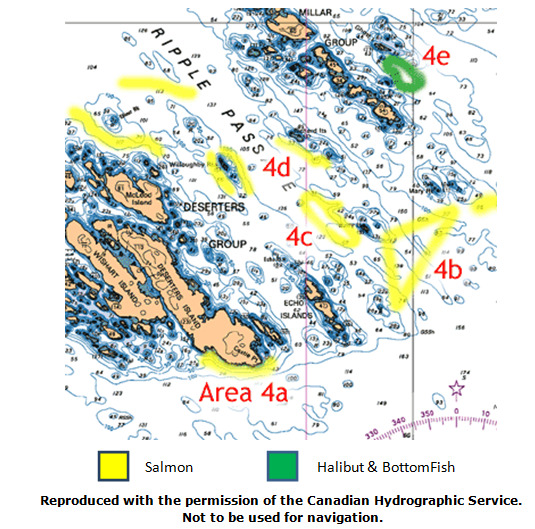
Area 4: Deserter Group – A group of islands that lies approximately 10 miles north of the Quartermaster Marina. It is six miles of open water to the Deserters once you leave the harbor, so while small boats often venture out there, if the wind comes up, it can be a dangerous ride home.
That said, the Deserters is one of the great areas to fish.
Area 4a) Castle Pt. – This is the most consistent area for Chinook! A very heavily fished area and can be crowded. The rules for fishing this point is that if your boat is traveling east to west, you have the right of way to fish close to shore in 50 ft. of water or less. Most Chinook are caught in the top 25-ft. of water here.
If you are traveling west to east, you should yield to the other boats and move to deeper water. Take this opportunity to drop your downriggers down to 85 ft. Many big Coho are hooked here as well as Chinook. Note this is not a spot for moochers, as the boat traffic is too heavy.
Area 4b) – This area should be fished like a triangle, starting just beyond the kelp beds and reefs past the Echo Islands, east to Mary Rocks, then back to Barry Island and finally troll back to your starting point. On the first leg of your troll, you will pick up primarily Coho and humpies. On the Mary Rocks to Barry Island leg, you will catch Coho and this is your best chance to hook Chinook. The final leg is primarily Coho and humpie water again.
Area 4c) – This is a good area to fish the bottom for halibut and a good mooching area for Chinook.
Area 4d) – Ripple Passage is a great area for big Coho. Chinook can be caught by fishing close to either side of Willoughby Rocks or the west side of Richards Light.
Area 4e) – Ghost Island: This area is best fished on the ebb tide for small halibut in the 15 to 40 pound range.
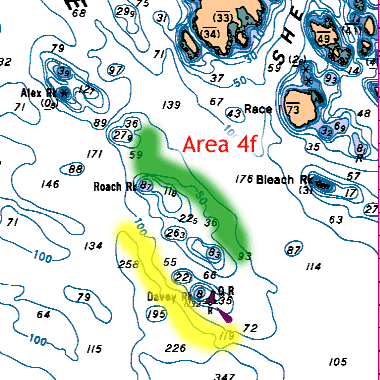
Area 4f) – Davey Rocks lies just south of Shelter Pass. Troll or mooch the southwest side for salmon. Fish the northeast part of the reef for halibut.
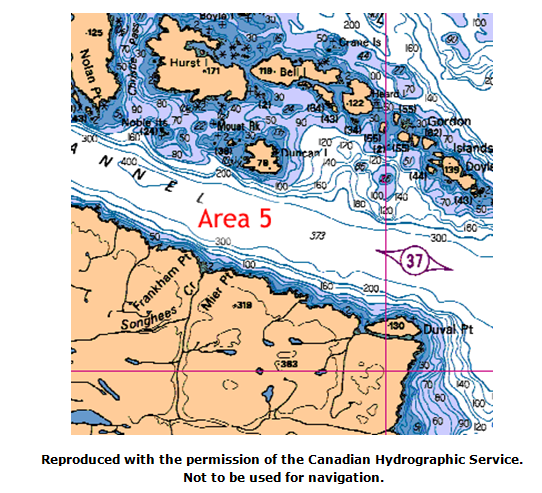
Area 5: Goletas Channel – Lots of water and lots of fish. This water is fairly protected and never crowded. Great fishing.
Fishing Tips
Chinook: Chinook are actively feeding and not necessarily found in deep water. You are just as likely to find them in the top 15 feet of water as 100 feet down. If you go to the bottom, you will be immediately dragging a brown rockfish. Most summer Chinook are caught in the top 65-ft. of water. Fish close to kelp beds and shorelines.
Lure Set Ups: A flasher with a six to seven ft. leader trailing a herring or anchovy rig is standard for this area. However, you can do just as well with artificial lures. A flasher with 48” of leader and a Sonic Edge spoon is deadly. Good colors are cop car, army truck and any of the glo greens. Gold Star squid in green or army truck colors are excellent.
A good rule: On bright days use light colored lures. On foggy or dark days, use dark colored lures. Add Smelly Jelly in herring, shrimp or anchovy scent!
Coho: Tide rips are always productive. The before mentioned Sonic Edges and squid will also catch coho. If you want a really good fight, try light tackle with the 8” flasher rigged with a #3 Kingfisher or Coho Killer spoon. You can use these with a 26 to 32 inch leader. Apexes fished by themselves are also a great light tackle lure.
Humpies: We never target humpies, as they come through in such numbers; you’re bound to catch them anyway. However, should you need a Humpie fix, a hot pink mini squid, especially the glo and pink Michael bait fished behind a flasher or dodger at a slow troll will fill your fish box in short order. Gold star color number is MBG183 for these squid.
Sockeye: Fishing for Sockeye is dependent on river returns. You can expect a season in early August. Openers will be announced within 48 hours of the starting date. Sockeye are strong and determined fighters, and Fraser River sockeye are usually bigger than Washington State sockeye. Michael Baits have a swivel in the head of the squid that helps offset the effects of a twisting sockeye and barbless hooks. Fish these squid 24 inches behind an 8” red flasher. Color numbers for the squid are MBG183 and MB181 will do the job.
Slow troll, change directions often and pull every other leg off of your Michael Bait. Fish depths: 35 to 90 feet.
Halibut: In addition to the areas marked on this map, Pine Island, Christy Pass and almost any reef will hold halibut.
The halibut in this area move around a lot, so fishing in a particular area may change from day to day. The best bait for halibut is salmon belly, followed by mackerel if available, and the white skin of the halibut.
How do you get there?
Take BC Ferries (www.bcferries.com) 888-223-3779 (http://www.bcferries.com) from Tswassen to Nanaimo and follow Island Highway North (19). Drive time from Nanaimo is approximately 5 hours if you are towing a boat. The highway is in excellent condition and four lanes to Campbell River. Beyond Campbell River to Port Hardy (150 miles) is a two-lane highway. The traffic is not heavy. The drive is scenic and there are many rest stops and points of interest along the way. I do recommend having a full tank of gas when you leave Campbell River.
Where do you stay?
Port Hardy is the connector for BC Ferries route to Prince Rupert. The town can become quite crowded with ferry passengers coming and going, so reservations are required.
Hotels & Motels
Quarterdeck Inn & Marina, 877-902-0459
Pioneer Inn 250-949-7271
Thunderbird Inn, 250-949-7767
Campgrounds
Quatse River Campground, 250-949-2395
Sunny Sanctuary Campground, 250-949-8111
If you happen to be in Port Hardy and the fishing is not so hot, be sure to give Quatsino Sound a try. Go to Coal Harbor, a 12-mile trip over well-paved road. Launch at the World War II seaplane ramp. From Coal Harbor to the fishing grounds is 21 miles of very sheltered water. Winter Harbor is about another 4 miles. It is an easy run back and forth. However, you add about 3 hours of travel and launching that could be spent fishing. There are some distinct advantages to staying in Winter Harbour. If you plan on staying in Winter Harbour, we recommend Dick’s Last Resort 250-246-3456. Dick has a place right on the water with access to the large government dock there in town.
Launching Ramps
1) Quartermaster Marina has an excellent ramp with dock. Trailer and vehicle parking is available. A small fee is charged. This area can sometimes get crowded.
2) A pair of good (side by side) launching ramps are located near the main ferry landing on the east shore of the inlet. Vehicle and trailer parking is available. These ramps are seldom crowded, but you may have a little trouble on extreme low tides.
Moorage
Quarterdeck Marina, 250-949-6551
How to Fish for Salmon | How to Catch Salmon | How to Fish for Tuna | How to Catch Tuna | How to Fish for Halibut | How to Catch Halibut





